Walking with Flowers (22-5-14)
 At the meeting last Monday, we were privileged to have the welcome return of Don Witton, the Godfather of euphorbias. His talk was about his two passions – walking and flowers.
At the meeting last Monday, we were privileged to have the welcome return of Don Witton, the Godfather of euphorbias. His talk was about his two passions – walking and flowers.
Don regaled us with his photos and stories of his walking expeditions around the world. He certainly does like his walking, from the Lake District to Table Mountain, some of it over extremely difficult terrain. In his own words, he does some “botanising” while walking. This included lupins, which are an invasive species in New Zealand and tobacco plants in the Pyrenees.
Many of the flowers he photographed did tend to be from the euphorbia family. But they would be, he is the euphorbia expert after all.
 We learned a lot about the different flowers and their habitats as well as about walking in hills and mountains in different countries. According to Don, all you need for walking are a hat, boots, rucksack and a map. But I am sure that some form of clothing is desirable as well.
We learned a lot about the different flowers and their habitats as well as about walking in hills and mountains in different countries. According to Don, all you need for walking are a hat, boots, rucksack and a map. But I am sure that some form of clothing is desirable as well.
When timing your walks, it is advisable to use the Naismith Rule. Allow one hour for every three miles and add half-an-hour for each 1000 feet climbed.
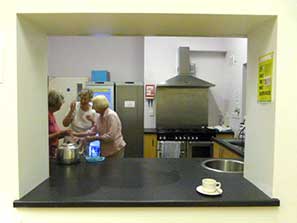 Apparently this works when walking in Britain, but not in the Alps as the paths are more difficult. So much for European collaboration!
Apparently this works when walking in Britain, but not in the Alps as the paths are more difficult. So much for European collaboration!
We were impressed with the enthusiasm Don always brings to his talks, and this was no exception. As he said “Walking with Flowers” is less dangerous than “Walking with Dinosaurs”, but only if you stay away from the edges of the cliffs and ridges!
Richard Turner
Gardening Club AGM 2014 (13-5-14)
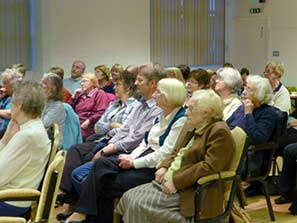 The first part of the April meeting on 28th April, was devoted to the Annual General meeting. Our Chair, Judy Thomas, summarised the wide range of activities enjoyed by the members. These included speakers, visits, socials, village planting and the annual and ever popular horticultural show. She provided us with a glorious presentation of photographs of the garden visits and highlighted the social nature and togetherness of our club. This is exemplified by the fact that all garden visits seem to end with tea and cakes!
The first part of the April meeting on 28th April, was devoted to the Annual General meeting. Our Chair, Judy Thomas, summarised the wide range of activities enjoyed by the members. These included speakers, visits, socials, village planting and the annual and ever popular horticultural show. She provided us with a glorious presentation of photographs of the garden visits and highlighted the social nature and togetherness of our club. This is exemplified by the fact that all garden visits seem to end with tea and cakes!
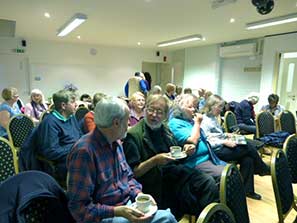 David Purcell presented the Treasurer’s report. As usual, he has overseen and kept the financial records superbly and the club has a healthy balance. Our many thanks to David for carrying out this task so admirably. He also produces the informative monthly newsletters which always look so professional.
David Purcell presented the Treasurer’s report. As usual, he has overseen and kept the financial records superbly and the club has a healthy balance. Our many thanks to David for carrying out this task so admirably. He also produces the informative monthly newsletters which always look so professional.
Judy appealed for more members to volunteer to help on the committee. Any help would be wel- come. We are particularly sad to see that David Purcell and Elaine Robinson are both stepping down from the committee, but not the club, after contributing so much to it’s growth and development. Elaine has organised the garden visits in recent years; a role she has done very efficiently with calm assurance.
 The members voted unanimously for the re-election of the remaining committee. Not surprising since Judy has contributed so much and done such a wonderful job as Chair. Carry on Judy!
The members voted unanimously for the re-election of the remaining committee. Not surprising since Judy has contributed so much and done such a wonderful job as Chair. Carry on Judy!
“A Greener Garden” John Draper“A Greener Garden” John Draper
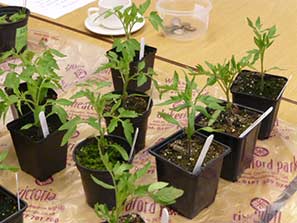 After refreshments (thank you Muriel and Margaret), the second half of the meeting was a talk from John Draper. John has been in commercial horticulture for thirty years and now runs the Greener Gardens lawn treatment service. He inspired us with his enthusiasm and knowledge of the huge range of products that are available for the amateur gardener.
After refreshments (thank you Muriel and Margaret), the second half of the meeting was a talk from John Draper. John has been in commercial horticulture for thirty years and now runs the Greener Gardens lawn treatment service. He inspired us with his enthusiasm and knowledge of the huge range of products that are available for the amateur gardener.
 Scientific advances have really revolutionised how we can improve the growth of, and protect, our plants. He explained about moss killers and weed killers – they are not the same apparently. Why slug pellets should be used sparingly, or alternatively use Nemaslug slug killer. The nematodes are slug parasites and will seek, search and destroy the slugs. Weapons of slug destruction! Patio Magic is brilliant for removing moss on drives, but do not use it on lawns, even if your moss is the duvet of death!
Scientific advances have really revolutionised how we can improve the growth of, and protect, our plants. He explained about moss killers and weed killers – they are not the same apparently. Why slug pellets should be used sparingly, or alternatively use Nemaslug slug killer. The nematodes are slug parasites and will seek, search and destroy the slugs. Weapons of slug destruction! Patio Magic is brilliant for removing moss on drives, but do not use it on lawns, even if your moss is the duvet of death!
Companion planting or integrated pest management is a simple way to prevent pests. One species of plant may help another by deterring the presence of pests. Plant roses and lavender together, or marigolds and tomatoes, or rhubarb and custard (I made that one up!). But probably the best advice was on looking after lawns. Cut lawns frequently and not too low, never more than one third off at a time. Our thanks to John for his informative and interesting presentation.
Richard Turner
Harlow Carr (30-4-14)
 It doesn’t matter how many times I go the RHS Harlow Carr there is always something to surprise and delight me. This time, the sun didn’t exactly split the heavens but it was dry and not blowing a gale – a vast improvement on previous visits.
It doesn’t matter how many times I go the RHS Harlow Carr there is always something to surprise and delight me. This time, the sun didn’t exactly split the heavens but it was dry and not blowing a gale – a vast improvement on previous visits.
I don’t know why but I didn’t expect to see much colour during this visit – how could I be so wrong! The plants that did it for me were the tulips. They were magnificent. Everywhere you looked they were exploding out of every kind of container in shades ranging from subtle and sublime to downright blowsy. And the containers were absolutely stuffed: goodness knows how many layers of bulbs there were to each pot but the results were stunning.
 And then there were the rhododendrons, camellias and azaleas making vivid splashes of colour in the woodland walk. Mind you, I’m not surprised that everything grows with such vigour. On our return circuit I noticed a large flower bed which had recently been emptied in readiness for summer planting and on top of this bed was a mulch of grit, horse manure and leaf mould and I swear it was nine inches deep – now then Monty Don, that’s what I call a mulch!
And then there were the rhododendrons, camellias and azaleas making vivid splashes of colour in the woodland walk. Mind you, I’m not surprised that everything grows with such vigour. On our return circuit I noticed a large flower bed which had recently been emptied in readiness for summer planting and on top of this bed was a mulch of grit, horse manure and leaf mould and I swear it was nine inches deep – now then Monty Don, that’s what I call a mulch!
 There’s always some form of planting that makes me think ‘why didn’t I do that’. This year it was grape hyacinths in hanging baskets – they looked like dangling balls of lapis at the entrance to the Edwardian garden. There was also a greater emphasis on natural planting this year with banks of cowslips, fritillaries, campions and birds foot trefoil making their way into the more formally planted areas.
Particularly poignant is the area dedicated to honouring those who fell in the Great War. I can just imagine the impact the area of red poppies will make.
There’s always some form of planting that makes me think ‘why didn’t I do that’. This year it was grape hyacinths in hanging baskets – they looked like dangling balls of lapis at the entrance to the Edwardian garden. There was also a greater emphasis on natural planting this year with banks of cowslips, fritillaries, campions and birds foot trefoil making their way into the more formally planted areas.
Particularly poignant is the area dedicated to honouring those who fell in the Great War. I can just imagine the impact the area of red poppies will make.
 Walking back up the steps and with the scent of hyacinth and narcissi heavy in the air I turned around to take in a panorama of all before me. What an idyllic spot – so what if it has its own micro climate (usually cold, wet and wild) – I can’t imagine a better place to be on a Sunday afternoon in spring.
Walking back up the steps and with the scent of hyacinth and narcissi heavy in the air I turned around to take in a panorama of all before me. What an idyllic spot – so what if it has its own micro climate (usually cold, wet and wild) – I can’t imagine a better place to be on a Sunday afternoon in spring.
Thanks to Elaine and Muriel for organising such a splendid trip – and to Marjorie too for ordering the weather!
Margaret Paul
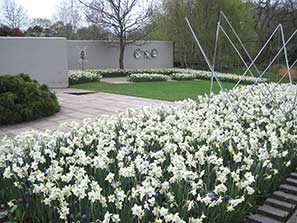
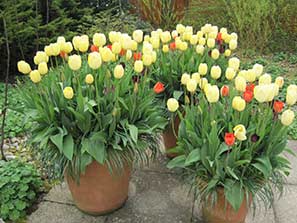



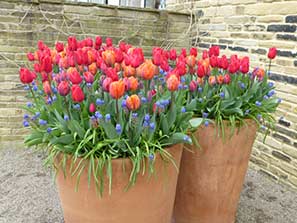
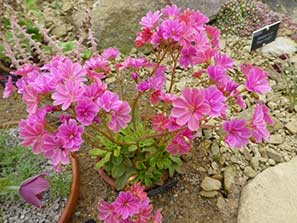





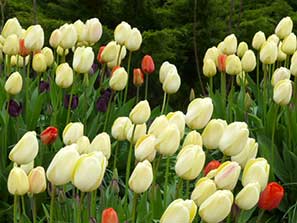
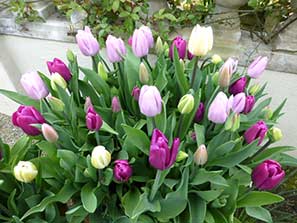
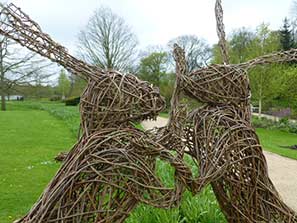
Photos by Judy Thomas and Mel Stanley
Haven for Hedgehogs (18-3-14 updated)
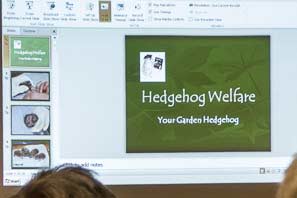 I have heard people say that they will always live in Cropwell Bishop because there is a good Health Centre here that will look after them in times of illness. If hedgehogs are able to talk to each other then I am sure that the ones who live in Grantham feel the same way about the home of Jan Peto.
I have heard people say that they will always live in Cropwell Bishop because there is a good Health Centre here that will look after them in times of illness. If hedgehogs are able to talk to each other then I am sure that the ones who live in Grantham feel the same way about the home of Jan Peto.
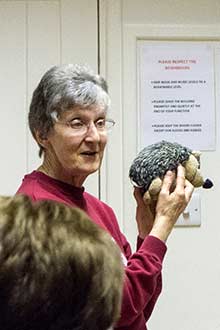 At this evening's meeting of the Gardening Club, 40 members were at the Old School to hear Jan describe in great detail how she is able to save the lives of ill or abandoned baby hedgehogs that people—and their children bring to her. If you know what it is like to bring up a baby, then you will have a good idea what it is like looking after baby hedgehogs.
At this evening's meeting of the Gardening Club, 40 members were at the Old School to hear Jan describe in great detail how she is able to save the lives of ill or abandoned baby hedgehogs that people—and their children bring to her. If you know what it is like to bring up a baby, then you will have a good idea what it is like looking after baby hedgehogs.
 The difference for Jan is that her baby hedgehogs are tiny and have an appetite for slugs and cat food. They also love a drink of beer and have been known to get drunk on party leftovers of canned lager. Also, they might well have half a dozen brothers and sisters who also need looking after at the same time.
The difference for Jan is that her baby hedgehogs are tiny and have an appetite for slugs and cat food. They also love a drink of beer and have been known to get drunk on party leftovers of canned lager. Also, they might well have half a dozen brothers and sisters who also need looking after at the same time.
Jan's talk left us in now doubt that her hedgehogs get 5-star care and she and her garden, shed and kitchen would all get an excellent rating in any Ofsted Inspection (hedgehog version).
If you want to find out more about hedgehogs, visit:
www.britishhedgehogs.org.uk
If you want a supply of suitable food for your own garden's hedgehogs, visit the very appropriately named website:
www.spikesite.co.uk
To learn more about hedgehogs, read Richard Turner's report of the presentation printed below.
Tony Jarrow

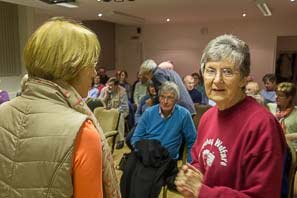
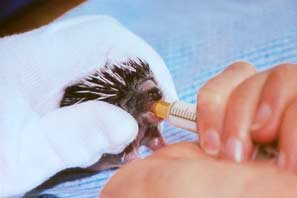 If your knowledge of hedgehogs was limited to Mrs Tiggywinkle and Spiny Norman then the talk from Janet Peto at the March meeting would have been a revelation.
If your knowledge of hedgehogs was limited to Mrs Tiggywinkle and Spiny Norman then the talk from Janet Peto at the March meeting would have been a revelation.
For thirty one years, Janet has been rescuing, saving then releasing these animals back into the wild. Her photos of the tiny babies and the care she takes to nurture them, and any sick or injured hedgehogs, is to be admired. Janet used her talk to tell us what we should, and shouldn’t be doing, to make sure that these lovely creatures maintain their place in our hedgerows and gardens.
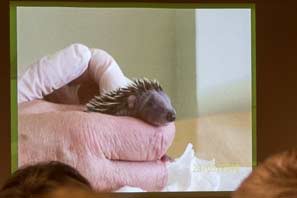 Hedgehogs have been around since the time of the dinosaurs and they are the gardener’s friend! These nocturnal animals eat half a pound of slugs, snails and caterpillars every night. At this time of year they are just coming out of hibernation and will have lost two thirds of their body weight. They also will be thirsty. More hedgehogs die of thirst than on the road! It is therefore vital that we leave a shallow dish of water out for the hedgehogs who may be visiting our gardens. They also will eat some dry cat food, but do not give them milk or bread. Once a week, Janet feeds her hedgehogs raw minced turkey thighs. Apparently this tastes just like worms. We will take her word for it!
Hedgehogs have been around since the time of the dinosaurs and they are the gardener’s friend! These nocturnal animals eat half a pound of slugs, snails and caterpillars every night. At this time of year they are just coming out of hibernation and will have lost two thirds of their body weight. They also will be thirsty. More hedgehogs die of thirst than on the road! It is therefore vital that we leave a shallow dish of water out for the hedgehogs who may be visiting our gardens. They also will eat some dry cat food, but do not give them milk or bread. Once a week, Janet feeds her hedgehogs raw minced turkey thighs. Apparently this tastes just like worms. We will take her word for it!
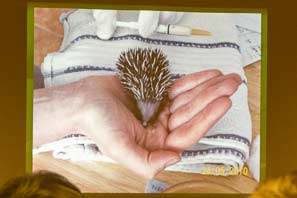 Hedgehogs have a great survival instinct and have only one natural predator - badgers. They are a protected species and you cannot remove them. She would prefer it if we did not use slug pellets in our gardens, use crushed egg shells or grit instead. Hedgehogs will be poisoned if they eat the dead slugs. Far from being a carrier of diseases, they are more likely to catch infections from us. It has been known for hedgehogs to catch colds and chicken pox.
Hedgehogs have a great survival instinct and have only one natural predator - badgers. They are a protected species and you cannot remove them. She would prefer it if we did not use slug pellets in our gardens, use crushed egg shells or grit instead. Hedgehogs will be poisoned if they eat the dead slugs. Far from being a carrier of diseases, they are more likely to catch infections from us. It has been known for hedgehogs to catch colds and chicken pox.
Our thanks to Janet for this enlightening talk about one of our oldest, native wild animals. Our admiration goes out to her for her time, effort and commitment to the welfare of this endangered species.
Richard Turner

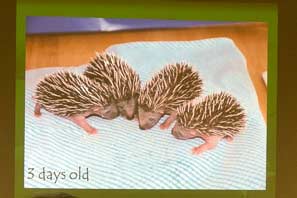


The Work of the Woodland Trust (18-2-14)
 “Create, Protect, Restore” is the mission of the Woodland Trust. At the last meeting, Gerald Price told us about the valuable work the trust is doing to look after our woodland. The trust is forty one years old and has 250,000 members. Not a huge amount but enough to make a difference to our natural landscape.
“Create, Protect, Restore” is the mission of the Woodland Trust. At the last meeting, Gerald Price told us about the valuable work the trust is doing to look after our woodland. The trust is forty one years old and has 250,000 members. Not a huge amount but enough to make a difference to our natural landscape.
What is woodland? Why is it important? What are the objectives of the Woodland Trust? This fascinating talk explained about the importance of woodland as a habitat. There is a wide range of wildlife which thrives, survives and is dependent on woodland. Tall trees provide a canopy for birds of prey. Undergrowth gives food and shelter for garden birds, dormice, badgers and deer. Ground cover, with both light and shade, allows the early flowering plants to flourish. Rotting wood has its role. It provides a home for beetles, woodlice and other decomposers which start the food chain by feeding the soil.
 Woodland comprises 12% of cover in the UK. This compares with 30-35% in the rest of Europe. 25% is thought to be about right to provide a healthy environment by generating oxygen by photosynthesis, stabilising soil and reducing water run-off. So we really do need to take action, to not only preserve, but generate more woodland. The trust has a vision to provide “a UK rich in native woods and trees enjoyed and valued by everyone”. What a laudable aim. Projects to re-plant woodland are taking place throughout the country. We saw examples of the growth of these after three and twelve years, but to reach maturity takes a lifetime. Ancient woodland has been around for four hundred years and restoring ancient woodland by planting more trees is a very, very long term project.
Woodland comprises 12% of cover in the UK. This compares with 30-35% in the rest of Europe. 25% is thought to be about right to provide a healthy environment by generating oxygen by photosynthesis, stabilising soil and reducing water run-off. So we really do need to take action, to not only preserve, but generate more woodland. The trust has a vision to provide “a UK rich in native woods and trees enjoyed and valued by everyone”. What a laudable aim. Projects to re-plant woodland are taking place throughout the country. We saw examples of the growth of these after three and twelve years, but to reach maturity takes a lifetime. Ancient woodland has been around for four hundred years and restoring ancient woodland by planting more trees is a very, very long term project.
A look at; visitwoods.org.uk reveals that there are six woods within a radius of five miles from Cropwell Bishop. We have our very own Hoe Wood and a visit to the Woodland Trust’s Springdale Wood at East Bridgford is thoroughly recommended. Explore, enjoy and savour the natural beauty, smells and sounds of our woodland heritage.
Richard Turner
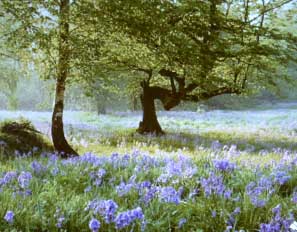

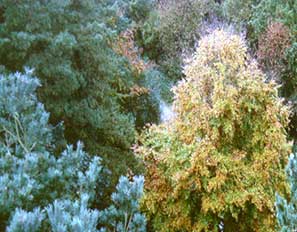


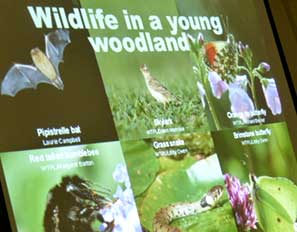
All about Orchids (24-1-14)
 My personal survival rate with orchids has been pretty poor. So I was delighted to hear the talk from Max Hopkinson from the East Midlands Orchid Society. Max is also a RHS judge; you cannot get more of an expert than that.
My personal survival rate with orchids has been pretty poor. So I was delighted to hear the talk from Max Hopkinson from the East Midlands Orchid Society. Max is also a RHS judge; you cannot get more of an expert than that.
Max told us that there are myths about orchids. They are difficult to grow – false. They are expensive – false again, but one did sell for £20,000. They are parasitic – again false.
There are 30,000 different species of orchid. The flowers all have three sepals and three petals. These vary in size; some flowers are the size of a pinhead while the largest can be eight inches in diameter.
Most orchids are epiphytes; they cling onto and grow on trees but get their nutrients from the air, not the tree. They are found from sea level up to 14,000 feet and most are tropical and like hot and humid conditions.
The majority do not have a scent. The seeds are tiny, like dust, and one seed pod can contain five million seeds. Some are edible (don’t try this at home) and did you know that vanilla comes from an orchid?
 Max gave us some tips on how to look after your orchids at home. They do not like draughts or direct sunlight. Keep them warm and humid, and water them only once a week. Max grows them in a mixture of bark and foam and suspends them from his greenhouse ceiling!
Max gave us some tips on how to look after your orchids at home. They do not like draughts or direct sunlight. Keep them warm and humid, and water them only once a week. Max grows them in a mixture of bark and foam and suspends them from his greenhouse ceiling!
Max certainly did whet our appetite for orchids judging by the number of questions and the response from those attending.
The annual show of the East Midlands Orchid Society is on the last Sunday in September at The Grange in Radcliffe. Put the date in your diary as it is a wonderful show of the range and variety of orchids.
Richard Turner
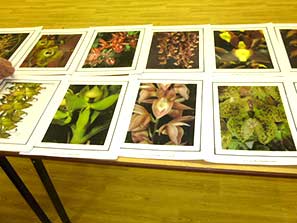
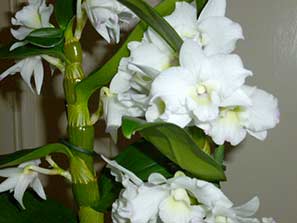
Once upon a time at Christmas: Nov 18th Meeting. (2-12-13)
 It is not Christmas yet, but at the last meeting, Tracey Akehurst delivered a fascinating talk on the history of our Christmas traditions.
It is not Christmas yet, but at the last meeting, Tracey Akehurst delivered a fascinating talk on the history of our Christmas traditions.
I thought that it was the Victorians who were responsible for our current Christmas customs. I was wrong. It all started when Roman Emperor Constantine converted to Christianity in 350AD. In doing so, he also hijacked existing pagan festivals and incorporated many of their practices, mainly eating and drinking to excess!
 The feast of Saturnalia, celebrating the
god of the harvest and fertility on 17th December was combined
with the winter solstice celebrations on 21st December.
Worship of the Sun and the turning of the seasons led to the
Norse tradition of the Yule log. A huge log would be burned for twelve days. After which the ashes would be spread on the fields. Fortunately the wood ash contains potassium which fertilised the soil.
The feast of Saturnalia, celebrating the
god of the harvest and fertility on 17th December was combined
with the winter solstice celebrations on 21st December.
Worship of the Sun and the turning of the seasons led to the
Norse tradition of the Yule log. A huge log would be burned for twelve days. After which the ashes would be spread on the fields. Fortunately the wood ash contains potassium which fertilised the soil.
Mistletoe was thought of as a highly magical and protective plant. It repels poisons, protects against lightning and cures epilepsy. But it really is poisonous itself, so don’t believe those druids! The early Christians objected to mistletoe in church. However, holly was an acceptable decoration. It protects against evil spirits, so it is used in Christmas wreaths, and in a thunderstorm it is the tree least likely to be struck by lightning.
 We were also told about ivy and it’s association with alcohol, Christmas tree firs from 8th century Germany and why sprouts are on the Christmas menu. Mince pies were originally a huge pie of rotting meat leftovers with added spices and fruit to disguise the taste! Plum pudding, poinsettias and the Glastonbury thorn were also described and discussed.
We were also told about ivy and it’s association with alcohol, Christmas tree firs from 8th century Germany and why sprouts are on the Christmas menu. Mince pies were originally a huge pie of rotting meat leftovers with added spices and fruit to disguise the taste! Plum pudding, poinsettias and the Glastonbury thorn were also described and discussed.
It was a thoroughly entertaining talk, full of facts, which was very well received. It only leaves me to “wassail” you and wish you the very best of good health in your forthcoming pagan rituals!
Richard Turner




